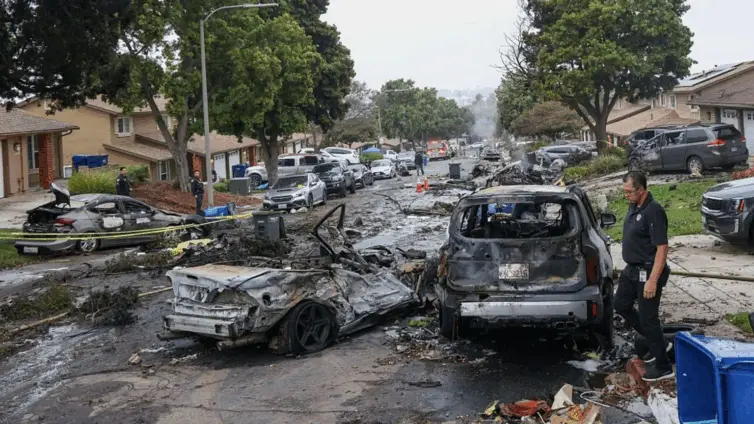The Lakeside community in Adentan Municipality, Ghana, is reeling from devastating floods that struck on May 18th, leaving three dead and causing widespread property damage. Amidst the wreckage, residents are leveling accusations at the engineers behind the East Legon Hills road construction, claiming that flawed drainage planning led directly to the catastrophe. The core of their complaint? A drainage system seemingly designed for disaster.
The community alleges that the road project diverted numerous water channels into a single, woefully inadequate outlet. The result, they say, was an overflow of epic proportions and the deadly flooding that followed. The question now being asked is stark: Could a more considered approach to drainage planning have averted this tragedy?
“The water was just too much,” said one resident, Ama Serwaa, whose home was partially submerged. “We’ve never seen anything like this before. It’s because of the road…they changed everything.”
Residents point to the fact that prior to construction, the rainwater had multiple outlets to flow through. Now, they say all of these have been funneled into one, causing devastating pressure and overflow on the single point.
According to JoyNews reports, the anger and grief are palpable as the community grapples with the aftermath.
The finger-pointing is directed squarely at what many see as a clear failure of foresight and engineering.
Prince Ansah, a local resident and business owner, doesn’t mince words when discussing the role of road contractors in the disaster. He holds them directly accountable for what he describes as poor construction practices and unfinished drainage work that ultimately contributed to the deadly flooding. “To the best of my knowledge, I believe the problem lies with the contractor who worked on the road,” Ansah stated, emphasizing what he sees as negligence on their part.
Ansah elaborates on specific issues he observed. He points to a gutter that was not built to a sufficient depth and lacked proper covering, leading to a rapid accumulation of rubbish. This, in turn, caused blockages that severely hampered the flow of water during the heavy rains. Furthermore, he argues that the entire drainage system was left incomplete, a critical oversight that allowed water to back up and inundate the surrounding area.
The consequences were personal for Ansah, whose car was damaged as a direct result of the blocked drainage. “The water rose so quickly, I couldn’t move my car in time,” he explained. “It’s not just about the property damage, though. People have lost everything.”
The sentiment of needing government intervention resonates strongly with Alex Narh, another resident of Lakeside. He broadens the scope of the issue, highlighting the fact that a major drain, serving areas as far-reaching as Katamanso and Nkansah Hospital, now redirects water directly into the Lakeside community. This influx is then compounded by the presence of buildings that have been erected on natural water paths, further exacerbating the flooding problem.
“What’s causing all these problems is the construction of a main drain from Katamanso, Nkansah Hospital, to this area, with all the smaller drains redirected here,” Narh explained, painting a picture of a community overwhelmed by water from multiple sources. He believes the situation demands immediate attention from government officials, urging them to conduct a thorough inspection of the area.
Narh’s appeal goes beyond immediate relief efforts; he calls for better drainage planning to prevent future disasters. He stresses the need to carefully assess the placement and construction quality of gutters, ensuring they are adequate to handle the volume of water they are intended to manage.
The Adentan flood causes are a combination of factors, all converging to create a perfect storm of disaster. Central to the issue is the undeniable fact of poor drainage planning and execution during the recent road construction. The new system simply lacked the capacity to cope with the sheer volume of water channeled into it, a flaw that proved fatal.
Contributing to the problem is the unchecked construction on natural waterways. As buildings encroach on these vital drainage paths, they disrupt the natural flow of water, increasing the risk of flooding. Adding to the mix is the persistent issue of drain blockage due to improper waste disposal. This blockage further reduces the efficiency of the already inadequate drainage system, exacerbating the impact of heavy rainfall.
To ensure flood prevention and avoid similar disasters in the future, a multi-pronged approach is essential. First and foremost, the government must hold engineers and contractors accountable for flawed planning and subpar execution. This accountability should extend to thorough inspections throughout all stages of construction projects, ensuring that proper drainage systems are implemented and maintained.
Furthermore, comprehensive waste management systems are needed to prevent the recurring problem of drain blockages. These systems should include regular waste collection and public awareness campaigns to educate residents on the importance of responsible waste disposal. In some cases, the relocation of buildings obstructing waterways may be necessary to restore natural drainage patterns and mitigate flood risks.
The tragic floods in Lakeside serve as a stark reminder of the potentially devastating consequences of inadequate drainage planning. The stories of residents like Prince Ansah and Alex Narh paint a vivid picture of a community struggling in the wake of disaster, highlighting the urgent need for government intervention and responsible infrastructure development. By addressing the flaws in the drainage system, holding accountable those responsible, and prioritizing public safety in urban planning, future tragedies can be averted, ensuring the safety and well-being of the Lakeside community and others like it.
Image Source: MYJOYONLINE





















